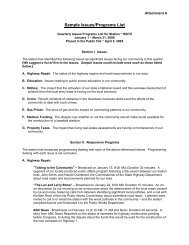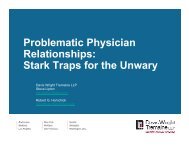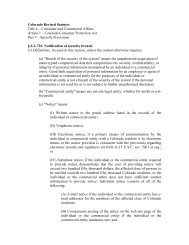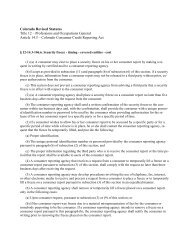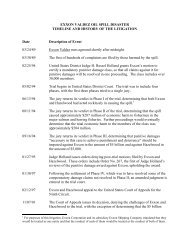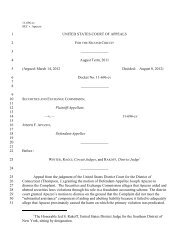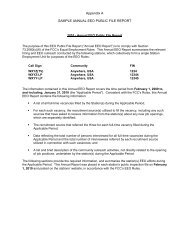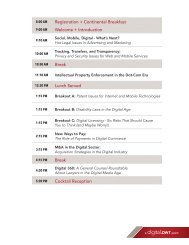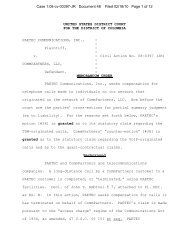QUANTA SERVICES INC, QUANTA SERVICES MANAGEMENT ...
QUANTA SERVICES INC, QUANTA SERVICES MANAGEMENT ...
QUANTA SERVICES INC, QUANTA SERVICES MANAGEMENT ...
Create successful ePaper yourself
Turn your PDF publications into a flip-book with our unique Google optimized e-Paper software.
Stock prices reflect the market’s<br />
expectations for the present<br />
value of future cash promised<br />
to the owner.<br />
Comparing the required future<br />
performance to historical<br />
performance positions<br />
investors to asses the feasibility<br />
of market expectations and<br />
valuations.<br />
See Appendix 4 for the specific<br />
estimates used in this<br />
company's valuation model.<br />
Appendix 2 details each<br />
Adjustment made to this<br />
company's reported financial<br />
results.<br />
Page 6: Qualifying Market Expectations<br />
®<br />
Quantifying Market Expectations<br />
Growth Appreciation Period<br />
$26.24<br />
$21.54<br />
17.6%<br />
Market Expectations<br />
based on current price<br />
$25.86<br />
11/30/2012<br />
We believe this stock has a Dangerous Risk/Reward Rating because there is a relatively<br />
large difference between the expected financial performance implied by its market price<br />
and the company's historical performance.<br />
Figure 7 compares the future performance required to justify the company's stock market<br />
price to its historical performance. Specifically, Figure 7 shows: to justify the current<br />
stock price of $25.86, PWR must grow revenues at 7.9% and maintain a 0.7% Economic<br />
Earnings Margin for 23 years.<br />
Figure 7: Future Performance Required to Justify Valuation<br />
Stock Price<br />
Performance Hurdles<br />
Revenue CAGR<br />
Avg Economic Earnings Margin<br />
5 Yr<br />
14.9%<br />
(4.6%)<br />
DUE DILIGENCE REVIEW<br />
Historical Performance<br />
$20.84<br />
18.0%<br />
(4.9%)<br />
Last FY<br />
(5.3%)<br />
Default<br />
7.9%<br />
0.7%<br />
23 years<br />
Source: New Constructs, LLC<br />
Note: The Default Scenario is Based on the forecast set by the New Constructs analytical team, this scenario<br />
represents a likely financial performance path the company may follow to justify the current market price.<br />
Subscribers to our services may create alternate forecast scenarios based on their own estimates.<br />
Historically, PWR has generated a Revenue CAGR of 14.9%, 18.0%, and 17.6% and<br />
Economic Earnings Margins of (4.6%), (4.9%), and (5.3%) over the past 5, 3 and 1<br />
year(s).<br />
The market expects PWR to achieve a Revenue CAGR of 7.9% and Economic Earnings<br />
Margins of 0.7% for 23 years.<br />
GAP measures the number of years implied by the stock price over which the company<br />
must maintain an edge over its current and future competitors. Specifically, GAP<br />
measures the number of years a company will earn returns on invested capital greater<br />
than its cost of capital on new investments. The law of competition dictates that a<br />
company can only grow its economic earnings for the finite period over which it can<br />
maintain a competitive advantage.<br />
The Market-implied GAP of the S&P 500 is 20 years. For the Russell 1000, it is 23<br />
years. PWR has a GAP of 23 years, which is similar to the indices. Based on this<br />
criterion, PWR has about the same chance of seeing price appreciation versus the<br />
indices.<br />
However, our Overall Rating is Dangerous. Other criteria (per pages above) in our<br />
rating system do not indicate PWR is an Attractive investment.<br />
GAP analysis comes from our dynamic discounted cash flow model, a multi-stage DCF<br />
model that values companies across multiple forecast horizons. Each forecast horizon<br />
(i.e., Growth AppreciationPeriod - GAP), assumes the company cannot grow profits<br />
beyond the GAP period. Our model exclusively uses no-growth terminal value<br />
assumptions for calculating the value of the stock for each GAP.<br />
The forecast drivers for our DCF model are: (1) Revenue Growth; (2) NOPBT Margin,<br />
(i.e. EBIT Margin with Adjustments*), (3) Cash Tax Rate, (4) Incremental Net Working<br />
and Fixed Capital needs. See Appendix 4 for the forecasts that drive our DCF model for<br />
this company.<br />
3Yr<br />
- -<br />
-<br />
Quanta Services, Inc. (PWR)




